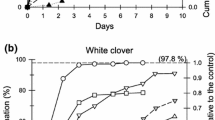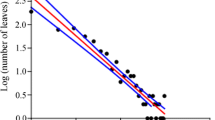Abstract
The aspen leaf miner, Phyllocnistis populiella, feeds on the contents of epidermal cells on both top (adaxial) and bottom (abaxial) surfaces of quaking aspen leaves, leaving the photosynthetic tissue of the mesophyll intact. This type of feeding is taxonomically restricted to a small subset of leaf mining insects but can cause widespread plant damage during outbreaks. We studied the effect of epidermal mining on aspen growth and physiology during an outbreak of P. populiella in the boreal forest of interior Alaska. Experimental reduction of leaf miner density across two sites and 3 years significantly increased annual aspen growth rates relative to naturally mined controls. Leaf mining damage was negatively related to leaf longevity. Leaves with heavy mining damage abscised 4 weeks earlier, on average, than leaves with minimal mining damage. Mining damage to the top and bottom surfaces of leaves had different effects on physiology. Mining on the top surface of the leaf had no significant effect on photosynthesis or conductance and was unrelated to leaf stable C isotope ratio (δ13C). Mining damage to the bottom leaf surface, where stomata are located, had significant negative effects on net photosynthesis and water vapor conductance. Percent bottom mining was positively related to leaf δ13C. Taken together, the data suggest that the primary mechanism for the reduction of photosynthesis by epidermal leaf mining by P. populiella is the failure of stomata to open normally on bottom-mined leaves.





Similar content being viewed by others
References
Abdel-Reheem S, Belal MH, Gupta G (1991) Photosynthesis inhibition of soybean leaves by insecticides. Environ Pollut 74:245–250
Bassman JH, Zwier JC (1993) Effect of partial defoliation on growth and carbon exchange of 2 clones of young Populus trichocarpa Torr and Gray. For Sci 39:419–431
Bassman J, Myers W, Dickmann D, Wilson L (1982) Effect of simulated damage on early growth of nursery-grown hybrid poplars in northern Wisconsin. Can J For Res 12:1–9
Bonan GB, Shugart HH (1989) Environmental factors and ecological processes in boreal forests. Annu Rev Ecol Syst 20:1–28
Churchill GB, John HH, Duncan DP, Hodson AC (1964) Long-term effects of defolation of aspen by the forest tent caterpillar. Ecology 45:630–633
Condrashoff SF (1964) Bionomics of the aspen leaf miner, Phyllocnistis populiella Cham. (Lepidoptera: Gracillariidae). Can Entomol 96:857–874
Cooke BJ, Roland J (2007) Trembling aspen responses to drought and defoliation by forest tent caterpillar and reconstruction recent outbreaks in Ontario. Can J For Res 37:1586–1598
Coyle DR, Nebeker TE, Hart ER, Mattson WJ (2005) Biology and management of insect pests in North American intensively managed hardwood forest systems. Annu Rev Entomol 50:1–29
Doak P, Wagner D (2007) Variable extrafloral nectary expression and its consequences in quaking aspen. Can J Bot 85:1–9
Faeth ST, Connor EF, Simberloff D (1981) Early leaf abscission: a neglected source of mortality for folivores. Am Nat 117:409–415
Farquhar GD, O’Leary MH, Berry JA (1982) On the relationship between carbon isotope discrimination and intercellular carbon isotope discrimination and intercellular carbon dioxide concentration in leaves. Aust J Plant Physiol 9:212–127
Farquhar GD, Ehleringer JR, Hubick KT (1989) Carbon isotope discrimination and photosynthesis. Annu Rev Plant Physiol Plant Mol Biol 40:503–537
Haile FJ, Peterson RKD, Higley LG (1999) Gas-exchange responses of alfalfa and soybean treated with insecticides. J Econ Entomol 92:954–958
Haile FJ, Kerns DL, Richardson JM, Higley LG (2000) Impact of insecticides and surfactant on lettuce physiology and yield. Hortic Entomol 93:788–794
Hering M (1951) Biology of the leaf miners. Junk, ’s-Gravenhage
Hogg EH, Brandt JP, Kochtubajda B (2002) Growth and dieback of aspen forests in northwestern Alberta, Canada, in relation to climate and insects. Can J For Res 32:823–832
Johnson MW, Welter SC, Toscano NC, Ting IP, Trumble JT (1983) Reduction of tomato leaflet photosythesis rates by mining activity of Liriomyza sativae (Diptera: Agromyzidae). J Econ Entomol 76:1061–1063
Kosola KR, Dickmann DI, Paul EA, Parry D (2001) Repeated insect defoliation effects on growth, nitrogen acquisition, carbohydrates, and root demography of poplars. Oecologia 129:1432–1939
Kruger EL, Volin JC, Lindroth RL (1998) Influences of atmospheric CO2 enrichment on the responses of sugar maple and trembling aspen to defoliation. New Phytol 140:85–94
Krugh BW, Miles D (1996) Monitoring the effects of five “nonherbicidal” pesticide chemicals on terrestrial plants using chlorophyll fluorescence. Environ Toxicol Chem 15:495–500
Mattson WJ, Addy ND (1975) Phytophagous insects as primary regulators of forest primary production. Science 190:515–522
Mattson WJ, Hart EA, Bolney WJA (2001) Insect pests of Populus: coping with the inevitable. In: Isebrands JG, Dickmann DI, Eckenwalder JE, Richardson J (eds) Poplar culture in North America. NRC Research Press, Ottawa, pp 219–248
Murthy CSHN (1983) Effects of pesticides on photosynthesis. Residue Rev 86:107–129
Nardini A, Raimondo F, Scimone M, Salleo S (2004) Impact of the leaf miner Cameraria ohridella on whole-plant photosynthetic productivity of Aesculus hippocastanum: insights from a model. Trees 18:714–721
Canada Natural Resources (2004) Yukon forest health report. Natural Resources Canada, Ottawa
Noormets A, Sôber A, Pell EJ, Dickson RE, Podila GK, Sôber J, Isebrands JG, Karnosky DF (2001) Stomatal and non-stomatal limitation to photosynthesis in two trembling aspen (Populus tremuloides Michx.) clones exposed to elevated CO2 and/or O3. Plant Cell Environ 24:327–336
Peña JE, Hunsberger A, Schaffer B (2000) Citrus leafminer (Lepidoptera: Gracillariidae) density: effect on yield of “Tahiti” lime. J Econ Entomol 93:374–379
Porter WB (1976) Aspects of the biology and dynamics of Phyllocnistis populiella Cham. (Lepidoptera: Phyllocnistidae) on trembling aspen in the Rocky Mountain Foothills of southern Alberta. PhD thesis, University of Calgary
Schaffer B, Pena JE, Colls AM, Hunsberger A (1997) Citrus leafminer (Lepidoptera: Gracillariidae) in lime: assessment of leaf damage and effects on photosynthesis. Crop Prot 164
Pritchard IM, James R (1984) Leaf mines: their effect on leaf longevity. Oecologia 64:132–139
Proctor JTA, Bodnar JM, Blackburn WJ, Watson RL (1982) Analysis of the effects of the spotted tentiform leafminer (Pyllonorycter blancardella) on the photosynthestic characteristics of apple leaves. Can J Bot 60:2734–2740
Raimondo F, Ghirardelli LA, Nardini A, Salleo S (2003) Impact of the leaf miner Cameraria ohridella on photosynthesis, water relations and hydraulics of Aesculus hippocastanum leaves. Trees 17:376–382
Reichenbacker RR, Schultz RC, Hart ER (1996) Articifial defoliation effect on Populus growth, biomass production, and total nonstructural carbohydrate concentration. Environ Entomol 25:632–642
Schowalter TD, Hargrove WW, Crossley DA (1986) Herbivory in forested ecosystems. Annu Rev Entomol 31:177–196
Spieser F, Graf B, Walther P, Noesberger J (1998) Impact of apple rust mite (Acari: Eriophyiidae) feeding on apple leaf gas exchange and leaf color associated with changes in leaf tissue. Environ Entomol 27:1149–1156
Stevens MT, Kruger EL, Lindroth RL (2008) Variation in tolerance to herbivory is mediated by differences in biomass allocation in aspen. Funct Ecol 22:40–47
Trumble JT, Ting IP, Bates L (1985) Analysis of physiological growth and yield responses of celery to Liriomyza trifolii. Entomol Exp Appl 38:15–21
US Forest Service (2005) Forest health conditions in Alaska - 2005. A forest health protection report. US Forest Service Alaska Region R10-PR-5
Welter SC (1989) Arthropod impact on plant gas exchange. Insect-Plant Interact 1:135–150
Whittaker JB (1994) Physiological responses of leaves of Rumex obtusifolius to damage by a leaf miner. Funct Ecol 8:627–630
Youngman RR, Leigh TF, Kerby TA, Toscano NC, Jackson CE (1990) Pesticides and cotton: effect on photosynthesis, growth, and fruiting. J Econ Entomol 83:1549–1557
Zangerl AR, Hamilton JG, Miller TJ, Crofts AR, Oxborough K, Berenbaum MR, de Lucia EH (2002) Impact of folivory on photosynthesis is greater than the sum of its holes. Proc Natl Acad Sci USA 99:1088–1091
Acknowledgements
We thank Bryan Carlson, Alina Cushing, Stephanie Joan Fischer, Trevor Fristoe, Zachary Meyers, E. Fleur Nicklen, Dianna Steiner, and Brian Young for assistance with data collection. Lilly Goodman and Peter Ray provided thoughtful comments on the manuscript. Roger Ruess and Dennis Fielding provided logistical support. Isotope chemistry was performed by Lola Oliver at the University of Alaska Fairbanks Forest Soils Laboratory. The research was funded by National Science Foundation award DEB 0543632 to D. W. and P. D.
Author information
Authors and Affiliations
Corresponding author
Additional information
Communicated by Evan DeLucia.
Rights and permissions
About this article
Cite this article
Wagner, D., DeFoliart, L., Doak, P. et al. Impact of epidermal leaf mining by the aspen leaf miner (Phyllocnistis populiella) on the growth, physiology, and leaf longevity of quaking aspen. Oecologia 157, 259–267 (2008). https://doi.org/10.1007/s00442-008-1067-1
Received:
Accepted:
Published:
Issue Date:
DOI: https://doi.org/10.1007/s00442-008-1067-1




